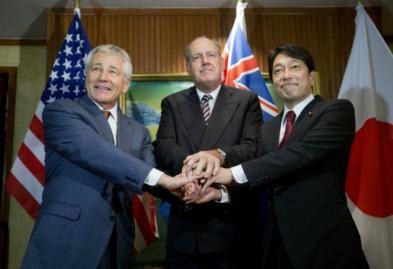CCP, an outlaw vs US Alliance

China and the US Alliance System


Philippines urges quick ruling in sea dispute with China
“The world should know by now that China is a danger to the civilized world. It has no intention in following international law and will invade neighbors whenever it can. It’s time for the world to push back because appeasing the greedy and morally corrupt never works. This is the lesson of World War II.” – Asean Military Defense Review (AMDR)
“As the Chinese military has been comprehensively modernizing its air, naval, and ground forces, it has been incorporating a variety of anti-access/area denial (A2/AD) systems and capabilities. These include not only weapons, such as anti-ship ballistic and cruise missiles, but also political warfare methods, including legal, public opinion, and psychological warfare techniques. To counter these A2/AD capabilities, the United States needs to adopt a comparably holistic approach, incorporating political measures, operational military deployments, as well as technical counters to Chinese military capabilities. Washington has one major advantage over Beijing – almost all of the countries on China’s littoral are U.S. friends and allies. Leveraging these relationships, and in the process underscoring American credibility and commitment, is key.” See US needs an integrated approach to counter China’s anti-access/area denial strategy

July 24, 2014: Worldwide Pinoy Protest vs China

Protesters in Manila denounce China’s bullying in South China Sea

Five Scenarios for East Sea
Before international law, historical evidence with legal values is the most convincing factor. China cannot give evidence.
Commentary, News, Update to US Asia-Pacific Alliance vs China: By now that AFP has minimally attained a credible military upgrade through EDCA together with the US Asia-Pacific alliance and union of nations to confront China, an international outlaw, which has violated UNCLOS and disregarded international experts debunking China’s 10-dash line claim together with the foreseeable favorable ITLOS arbitration outcome by December 2016 for the Philippines junking China’s 9-dash line claim and continued reclamation of Spratly islands, as I predicted in my statements last June 12, 2014, is the South China Sea on the brink of war?
“Aggression or intimidation or use of brute military force in settling any territorial issue are taboo in today’s global environment where the comity of nations and arbitration of territorial disputes provide proper avenues for amicable and peaceful settlement of conflicting territorial claims,” Rep. Rodolfo Albano said to President Aquino.
“Yes, Philippines and China should work together, but get out first of Mischief Reef, Scarborough Shoal, Ayungin Shoal, Mabini Reef and other parts of our EEZ! Then let’s talk!”- Roilo Golez
“We have to make the Chinese leadership understand that unilateral change and the rule of force is not acceptable,” Cronin said. Therefore, strengthening the regional cooperation among US partners like Japan, the Philippines, Vietnam, Malaysia and others is of the essence, he added. See Conference in Washington slams Beijing’s aggression in South China Sea
“Any military in the world that uses its power to bully, intimidate and destabilize the economy of the world, is not in the United States’ best interests, nor of our allies nor our friends,” Rogers told the Center for Strategic and International Studies think tank.
“It is of U.S. national interest to help solve this problem, to push back on aggressive Chinese efforts in the region,” he said. Republican intel chief: Get tougher on China

Philippines flays China’s position on South China Sea
As a pacifist myself who believes in UNCLOS arbitration and boycotting China made products as the peaceful way to resolve sea disputes and doesn’t believe in uncivilized violence, aggression, intimidation or war, I believe in the middle path and definitely agree that AFP must show some bite and not all bark now to destroy the future Chinese military bases, a natural shield against US, now because we are losing reefs and above all our national security is at risk. The commentaries by Acedillo, Ex-US Admiral Blair and Ted Laguatan make sense in that Chinese military bases in the reefs and shoals in the Spratlys close to the Philippine islands pose a real military threat to Philippine sovereignty and security. However, while the Philippines concerns itself with Chinese invasion in its own reefs and atolls (incursion in Recto Bank), I believe China’s economic downturn amidst added destabilizing relentless aggression and intimidation towards the sovereignty of Vietnam and Japan will backfire karmically sooner or later and either eventually bankrupt China or spark a naval war in the S. China Sea that will drag treaty allies such as the Philippines, US, Indonesia, Malaysia, Japan, and Australia that follow and are bound by the rule of international law.

New China incursion hit
“To secure ourselves against defeat lies in our own hands, but the opportunity of defeating the enemy is provided by the enemy himself.” – Sun Tzu, The Art of War

Philippine Navy most capable warship
Of utmost priority is the state of military preparedness – interoperability, training and modernization of the Philippine air force with the purchase of multipurpose F-50 jet fighters, support planes, drones with attack helicopters together with the Philippine navy’s frigates, submarines and corvettes armed with missiles and armaments coordinated with ground AFP armed with coast to coast missile systems and radar communication.
At the Asia Defense Forum last May, 2014, Chuck Hagel said China was a destabilizing presence in the region and if we want to maintain the status quo, it will require the cooperation of the US with many of its allies in the region to make sure that China doesn’t destabilize that region. See China, US looking for economic stimulus that comes from militarization, US sending battle-scarred troops to Philippines – Goldgerg, No bullying, US tells China, US General: Conventional conflict threat highest in Asia Pacific
But still, “China’s Military force is weak” and this is what fears them to double its expenditures. Its Chinese military has “female attributes”, “corrupt” as mention on its own book illustrating their brothers. Machine power is nothing if your military are not well trained and even they modernize their weapon its new technology is not enough to compete.
“China might be strong as what we see on media, but without experience they are nothing”, “we haven’t seen China engage into actual military combat”, one of the analyst says. See China’s nightmare that every country should know, China hits Philippines over extended oil drilling
US Senate passed resolution on South China Sea
By US Congress
States that the Senate: (1) condemns coercive actions or the use of force to impede freedom of operations in international airspace to alter the status quo or to destabilize the Asia-Pacific region; (2) urges China to refrain from implementing the declared East China Sea Air Defense Identification Zone and to refrain from taking similar provocative actions elsewhere in the Asia-Pacific region; (3) commends Japan and the Republic of Korea for their restraint; and (4) calls on China to withdraw its HD-981 drilling rig and associated maritime forces from their current positions, refrain from maritime maneuvers contrary to the Convention on the International Regulations for Preventing Collisions at Sea, and return to the status quo as it existed before May 1, 2014.
Sets forth U.S. policy regarding: (1) supporting allies and partners in the Asia-Pacific region; (2) opposing claims that impinge on the rights, freedoms, and lawful use of the sea; (3) managing disputes without intimidation or force; (4) supporting development of regional institutions to build cooperation and reinforce the role of international law; and (5) assuring continuity of operations by the United States in the Asia-Pacific region.
Resolution agreed to in Senate with amendments and an amended preamble by Unanimous Consent on July 10, 2014
See US Senate passed resolution on South China Sea

United States: We are not outsiders in Asia

Vietnam, Philippines cheer as US lawmakers war of words against China

China ends drilling operations in disputed waters off Vietnam
My predictions a month ago:
“I believe that regardless of a favorable outcome of the Philippine’s memorial submission to ITLOS, China will still use threats of force, intimidation, coercion and gunboat diplomacy because China will disregard the arbitration outcome and a tribunal can’t stop China from bullying its neighbors posing a complicated challenge to the region’s peace and security unless a necessary boost in military hardware upgrade capability in the Philippines is attained together with a US asia-pacific alliance, sanctions and a strong international support to militarily confront or deter China’s armed invasion collectively thereby upholding the rule of international law, unimpeded trade and freedom of navigation. What other viable peaceful options do we have to resolve China’s expansion agenda with invasive armed aggression?
With China’s disregard to UN arbitration and international law’s UNCLOS by its illegal declaration of sovereignty to all of South China Sea with its unilateral attempts to assert its bogus 9-dash line claims through its show of intimidation or force in the Philippines and Vietnam, will the group of G-7 still remain silent to China’s military intentions or act on its mandate to oppose China’s actions now?
Since the problem is a state of unpreparedness – the lack of military capability of the AFP now, I believe that a viable alternative or contingency measure to the current sea dispute situation between China and the Philippines would be for the G-7 allies to provide the AFP with the necessary training and credible number of military hardware such as warships, missiles, fighter planes, and drones, on loans, to counter Chinese invasion of Philippine reefs and shoals. Well trained and credible armed Filipino soldiers have done their own fighting before against internal terrorists, in the Korean war and in WW2 and as first defenders before other nations will intervene, AFP will fight these Chinese invaders and outlaws again with a credible military hardware upgrade to protect its sovereignty and prevent further loss of more rich natural resource Philippine territories to China.”
See Hong Kong marches in protest of Chinese control, Passions run high as Hong Kong marches for democracy
The main reasons for my predictions:
“We reiterate that such a publication only shows China’s unreasonably expansive claim that is clearly contrary to international law and UNCLOS,” Foreign Affairs spokesman Charles Jose said in a text message.

China’s new map covers West Philippine Sea
– Singapore PM Lee Hsien Loong
At a joint press briefing with Del Rosario, Kishida called for stronger ties with the Philippines to “ensure regional peace,” amid tense territorial disputes in the West Philippine Sea.
“On the political and security front, we agreed on strengthening policy dialogue and enhancing maritime cooperation on other matters,” Kishida said.
This was music to the ears of Philippine officials. The president and Kishida also discussed “common challenges” that both the Philippines and Japan face with China’s growing assertiveness in the West Philippine Sea.
More important to Filipinos is that the Philippine-Japan entente has gone beyond tough words without teeth. The meetings with Kishida hit hard ground. They talked about Japanese help in improving the PCG’s capability — so Philippine naval ships can fire back and sink enemy ships.
“The acquisition of multipurpose vessels is undergoing serious consideration,” Del Rosario said.
This is the kind of language that China respects because these are words backed by military hardware.
See Taiwan tagged Philippines as China’s most bullied country – Japan come to the rescue, Philippines backs Japan bid to defend allies, Japan, Philippines say rule of law should settle disputes, US backs Philippine protest over Chinese reclamation, twits 10-dash line, It is getting worse: 12 Chinese ships monitored inside Philippine’ EEZ, China’s new territorial law could spell disaster, US should act unilaterally act to protect the smaller nations of the S. China Sea, US: China claim problematic, US gets no vow from China to stop sea coercion, Hoping to project power, China finds itself alone, A look at China’s territorial claims, This Map shows why the South China Sea Could Lead to the Next World War, Australia joins Japan, Vietnam, Philippines in opposing China, US Senate reaffirms commitment to defend Philippines, Japan, US proposes construction freeze in South China Sea, Palace welcomes US Senate resolution backing Philippines on sea dispute

This Map shows why the South China Sea Could Lead to the Next World War

Australia joins Japan, Vietnam, Philippines in opposing China

US Senate reaffirms commitment to defend Philippines, Japan

US proposes construction freeze in South China Sea

China and Strategic Imbalance

After HYSY-981: A US-Vietnam Alliance?
Japan PM Shinzo Abe
Japan’s prime minister Shinzo Abe’s declaration of aid for Asian countries, coupled with offers to sit down for talks with China, is a major step that could well offer a pathway to new stability in the region’s seas – if China will respond better than its bluster at the recent Shangri-La Dialogue, the Asia Security Summit in Singapore.
Freedom of the seas has been accepted worldwide since the days of the early Greeks and Romans, Japan’s Abe told the meeting in Singapore. He described the rule of law at sea and asked, “What exactly do we mean in concrete terms?” He answered with three principles:
- States shall make and clarify their claims based on international law.
- States shall not use force or coercion in trying to drive their claims.
- States shall seek to settle disputes by peaceful measures.
If China continues to disregard these principles and stays in the internationally accepted zones of countries such as the Philippines and Vietnam, it may well be the other side of Abe’s dual offer – defensive armed aid to those countries – that will deter aggression and bring stability back to Asia.
See Japan to China: Let’s talk regional peace, but meanwhile we will arm our neighbors, NATO urges China to be responsible power in sea row, Japan sets landmark easing constitutional limits in military, Japan: the Philippines’ new best friend?, What Japan’s ‘collective self-defense’ can mean to Philippines?, Japan can now defend other nations, Japan able to aid US ships under attack – minister, US hails Japan easing of restrictions on military

Japan inches closer to major power status

Japan, France to enhance defense cooperation

Red Team Analysis: What a Russian pivot east might mean for Japan

Yes, the US really will defend Japan

Japan white paper slams China over disputed territory
Australian and Japanese defence and foreign ministers, meeting in Tokyo this week for so-called 2+2 talks, laid out an agenda for stepped-up military collaboration throughout the Asia Pacific region. The Obama administration has encouraged closer ties between its two allies, as part of its “pivot to Asia” and preparations for war against China.
Wednesday’s meeting followed a summit in April between Australian Prime Minister Tony Abbott and his Japanese counterpart, Shinzo Abe, at which it was agreed to upgrade the strategic partnership between the two countries. Abe is using the developing military ties with Australia to press ahead with his efforts to remilitarise Japan, including ending constitutional restraints on the forging of military alliances and the sale of Japanese military hardware.
See Australia, Japan forge closer military ties

Australia: We will stand up to China
“The weakness of China is it doesn’t have an anti-submarine warfare… that’s why many countries are interested in Japan,” Shinzo Abe added.
He said Japan is thus giving a clear signal to China: “If you continue to be aggressive in your pursuit of territorial claims, you’re not just going to empower historical rivals but you’re going to create a coalition against you in the region.” China soon to be the boss in West Philippine Sea
‘Only war’ will disrupt trade routes
Shivaji Das, a Singapore-based senior vice president with global consultancy firm Frost and Sullivan, said only a war would lead to a disruption of the South China Sea trade routes.
“And I don’t see that happening. All the countries have an immense stake (in keeping the trade routes open),” he said.
Das also said the rules of “freedom of navigation” in the sea had rarely been broken by governments anywhere in the world in recent history, with those threats coming more from piracy.
“When it comes to commerce, all the countries have their exclusive economic zones but they still allow for freedom of navigation of merchant ships. And that won’t be affected unless there’s an actual conflict in the zone,” he said. See South China Sea trade routes safe despite rows,
Taking up an American diplomat’s suggestion, the Philippines will propose a “moratorium” on moves that worsen tensions in the disputed South China Sea, Philippine Foreign Secretary Albert del Rosario said Monday, June 16.
In an interview on ANC’s Headstart, Del Rosario said the Philippines wants to formally propose this “within the year” to ease tensions in the disputed waters, parts of which the Philippines claims as the West Philippine Sea.
He said the moratorium should involve the Association of Southeast Asian Nations (ASEAN), particularly the South China Sea’s claimant states, as the region works on a Code of Conduct (COC) in the South China Sea.
The legally-binding COC is seen to replace the non-binding, 12-year-old Declaration on the Conduct of Parties in the South China Sea (DOC).
“We ought to maybe consider getting together and saying, ‘Let’s freeze all activities which escalate tension,'” Del Rosario said.
He added: “Let’s call for a moratorium in terms of activities that escalate tension. Let’s do that while we work on an expeditious conclusion of the COC and effective and full implementation of the COC…. I would like to initiate it, and I think it’s a reasonable approach.” See Philippines eyes ‘moratorium’ on South China Sea tensions
China rejected a suggestion by the Philippines on Monday for a region wide ban on construction in the South China Sea after Beijing began building a school on a rugged outpost it created to strengthen its claims to disputed waters. See China rejects Philippines call for construction ban in disputed sea
China appears to be constructing an airstrip and sea port on Fiery Cross Reef in the South China Sea, according to regional media reports, in a move that looks like the next step in its efforts to claim the entirety of a water area roughly the size of India.
The expansion is part of numerous reef reclamation efforts being made by China, said Guy Stitt, president of AMI International Naval Analysts & Advisors. “China continues its slow fortification of the claims within its 9-Dash Line,” which outlines China’s purported “indisputable sovereignty” of the South China Sea.
China has active expansion programs on Gaven Reef and Cuarteron Reef, and the placement of a port and airstrip on Fiery Cross or any of the others would “be used to counter a US presence in the Philippines,” said Carl Thayer, a professor at the Australian Defence Force Academy.
The US military must now face the very real possibility that the People’s Liberation Army (PLA) will use these islands to implement a new air defense identification zone similar to the one created in the East China Sea last November.
An airbase on Fiery Cross Reef would give China de facto military control over the South China Sea airspace since it would allow shorter-range tactical aircraft with a heavier weapons load to operate in the airspace, an advantage over having to send tactical aircraft from the mainland in event of a potential conflict, said Sam Tangredi, author of the new book, “Anti-Access Warfare: Countering A2/AD Strategies.”
The US Navy will not face off just against the PLA Navy, but against the PLA Air Force, which can operate shore-based aircraft against ships at sea, and against the Chinese Army, which operates China’s inventory of anti-ship ballistic missiles, the DF-21D, said James Holmes, a professor of strategy at the US Naval War College.
“If you can hold a stronger navy like the US Navy at bay with shore-based weaponry,” the 21st-century counterpart of fortress guns, “that liberates the PLA Navy fleet to venture outside the Western Pacific and China seas,” he said. “It also means the PLA doesn’t need to build a navy as big or powerful as the US Navy to accomplish what China’s leadership wants the PLA Navy to accomplish in East Asia.”
Tangredi said he does not believe that a sea port and air strip on Fiery Cross would be doable or even comparable to Diego Garcia in the Indian Ocean, but “if you combine an airbase at Fiery Cross with a developed anchorage amongst other reefs, that makes for a more formidable naval base.”
Diego Garcia is an atoll, not a reef, with a sheltered lagoon and room enough to support a maritime prepositioning squadron, all of which Fiery Cross Reef lacks, he said.
The fear is that all the other claimants, including Vietnam, the Philippines and Malaysia, will begin building fortifications on reefs, islets and rocks, said Andrew Erickson, a China naval specialist at the US Naval War College.
The fear is that all the other claimants, including Vietnam, the Philippines and Malaysia, will begin building fortifications on reefs, islets and rocks, said Andrew Erickson, a China naval specialist at the US Naval War College.
“Will we increasingly witness an arms race of augmentation as rival claimants fortify features under their respective control with structures, ships, and sand?” he asked.
Erickson questions what this will mean for the otherwise potentially moderating influence of existing norms and international agreements such as the UN Convention on the Law of the Sea if islets, reefs and rocks are substantially enhanced.
“What will it mean for South China Sea stability if additional military airstrips are built? My forecast: nothing good,” Erickson said.
China’s assertiveness in the South China Sea over the past few years is significant as it “directly challenges America’s position as the primary maritime power in Asia and as the guardian of the old regional order,” said Hugh White, author of the new book, “The China Choice: Why America Should Share Power.”
White said those in Washington who assume China would not challenge the US in Asia “need to reconsider their assessment and think deeply about how to respond.”
He said the US should no longer assume China would back down from a US military counter-challenge. Those days are long past. The US needs a “more sophisticated diplomacy” that will “avoid escalating rivalry.”
“The underlying demand is that the United States needs to clarify its true interests in the Asia-Pacific and to define what elements of our Asia strategy are important to us and which we can live without,” Stitt said.
“I can’t help but think that America’s vacillation over our policy with Ukraine has served as an indicator to China to amplify their efforts in the South China Sea.” See Beijing continues S. China Sea expansion
Statements coming from Foreign Secretary Albert del Rosario betray helplessness over the situation in the South China Sea.
The Philippines is losing the battle that he led the country to wage against China. See Del Rosario fights media battle while China controls battlefield
He said the manner by which the DFA was pursuing the Philippines’ arbitration case against China in the United Nations was another “exercise [of its] naivete.”
Acedillo said that while he supported the arbitration case, the DFA must not “tie the hands of all our maritime and naval agencies [to prevent them from doing] anything that would jeopardize our pursuit of the case.”
He said the government must send more Coast Guard vessels to mark the Philippines’ territory in the West Philippine Sea and be as assertive as China.
While the Philippines follows the Declaration of the Conduct of Parties in the South China Sea, which adheres to a status quo in the disputed territories, “our lack of action to strengthen or improve our installations in the area has only sent a clear message to the Chinese and that is we are all bark and no bite,” Acedillo noted.
“And this has only encouraged Beijing to move more aggressively as they know we will not act,” he added.
He urged the government to take a more decisive action in protecting the country’s territory. See Philippines becoming a thorn in China’s side
Philippines must stand up to China
The Philippines has to stand up to China’s gray-zone challenges in the hotly contested South China Sea, instead of only reacting to its behavior.
Dennis Blair, retired chief of the United States Pacific Command and former Director of National Intelligence, said the Philippines, Japan and Vietnam “can’t just sit there” and watch as China encroaches in what they consider sovereign territories.
“Of course, you need to think them through carefully, but if the Chinese want to play a game of ‘I’ll poke you here, and I’ll poke you there,’ then you have to respond and say, ‘Game on.” Blair said in an interview with Asahi Shimbun, a transcript of which was posted Wednesday.
“Japan, the Philippines and Vietnam need to take initiatives of their own and be equally forceful in that space,” the acknowledged Asia expert advised. See Ex-US Admiral: Equally forceful Philippines needed in sea row
Destroy China’s military bases now
However, it will take another two years or so before a decision is made. Moreover, China has refused to play by the rules and defiantly declared that it would not respect the decision of ITLOS. As such, the Philippines cannot rely on this court action to solve this difficult problem of a deceptive and powerful bandit-like rogue state stealing islands, atolls and valuable resources.
Meanwhile, knowing that the Philippines neither has the navy nor the air power to stop it, China continues to take over more Philippine islands and atolls. Chinese fishermen also poach continuously in Philippine waters. The Chinese are now even rushing land reclamation military bases projects in various areas they seized inside Philippine territory. These future bases are within easy striking distance to major cities in the Philippines and surrounding ASEAN countries. Once these military bases are built, it would practically be impossible to remove them.
Having enemy fighter planes and missiles so proximate to potential target cities is like having a bag of explosives padlocked on one’s neck by a bad guy with a remote control, which he could explode anytime. The baddie has the poor guy under his complete control.
With these bases in place, China can demand anything from the Philippines and take anything it wants. For all practical purposes, the Philippines will then be a slave nation. We would be fools to block this unpleasant reality from our minds and not try our damnest to prevent this terrible situation. We cannot afford to be cowards and be intimidated.
China could also claim later that since they now owned these islands under UNCLOS, all of the areas within 200 miles from the baselines of these islands belonged to them.
The Philippines must request from her mutual security partners the means to destroy these future bases now and the assurance of full support against retaliation. Enough persuasive reasons can be presented to the leaders of the US Japan and Australia to provide to the Philippines the needed planes, smart powerful bombs, drones and technical advice.
After these bases are destroyed, the US, Japan, Australia, the Philippines and other allies must immediately announce a message to this effect:
“In its legitimate exercise of self defense, the Philippines has destroyed future Chinese military bases deep within Philippine territory that were being illegally constructed by China on Philippine atolls and islands in violation of international law. Not only is the national security of the Philippines threatened by these future military bases, they also threaten the national security of several surrounding countries: Vietnam, Indonesia, Malaysia, Brunei, Japan, Palau, Taiwan, Cambodia, South Korea, Thailand, Laos, Myanmar and Singapore.
If China retaliates against the Philippines in any manner or form, it will face the same retaliation from the United States, Japan, Australia, Vietnam and other allied nations.”
With this fair warning, if China still retaliates, it risks annihilation — military, economic or otherwise.
We really have no choice: We have to destroy these future Chinese military bases now. See No choice: Destroy China’s Philippine military base now
The deployment of submarines by China and the United States in the South China Sea may lead to the escalation of conflict in the disputed waters, a US-based consultancy firm said.
One potential parameter of instability in the East and South China Seas is the additional deployments of submarines by China in the disputed areas, according to simulations conducted by Wikistrat, a consultancy firm for strategic analysis and forecasting.
It noted that earlier this year, China deployed all three of its Type 094 nuclear missile submarines in the South China Sea as part of its naval strategy for nuclear deterrence. The United States responded by sending one of its submarines, the USS North Carolina, to the region to begin patrols and monitor Chinese activity.
According to Wikistrat, this could lead to escalation of conflict as other countries redirect their naval forces and submarines to the South China Sea as well, especially the Philippines and Vietnam which see China’s increased submarine deployments as a response to their own naval modernization efforts, including the latter’s acquisition of the Russian Gepard-class frigate and the Dutch Sigma-class corvette. See China, US deploy submarines in disputed South China Sea
See Philippines wants early delivery of radar for APEC 2015 surveillance

Mini-Munitions drawing big attention

Philippines set out capability upgrades at inaugural ADAS show

Folding Gun? High-tech weapons wow Philippine soldiers

DND orders 10 small amphibian vehicles for the marines

US to give C-130 planes to Philippines

Naval ships from US, India and Japan to start war games

AFP awaits SC decision on EDCA fate

Rules-based approach to sea row

Bill Clinton slams Beijing on South China Sea

China adds East China sea drills to spate of military exercises

Did China blink in the South China Sea?

Maritime disputes could lead to war

Satellites and Seafood: China keeps fishing fleet connected in disputed waters

China’s 50,000 Secret Weapons in the South China Sea

China just weaponized its Fisherman

Coast Guard, BFAR recover 2,000 kilos of shark skin in Zamboanga City

Aegis, Missile Defense and the US pivot

US welcomes China’s RIMPAC spying

Breaking Through China’s Great Firewall

Chinese Hackers Target Israel’s Iron Dome

State of Philippine Navy modernization: Golden days will return

Philippines seeks international backing on action plan to resolve sea row

Financial Crisis Made in China

China covers-up Anti-Satellite Test, Again

China admits it has nukes that can reach US

China says can build what it wants on South China Sea isles

US: China Sea claims must be based on land features

Row over provocative South China Sea acts looms ahead of ASEAN talks

China plans to build lighthouses in disputed sea

Philippines to upgrade Spratlys airstrip amid moratorium bid

Vietnam decries China’s illegal activities on Paracel Islands

China rejects Philippine proposal on South China Sea disputes

China rejects US proposal to ease South China Sea tensions

US won’t confront China in bid to cool sea tensions

China hits out at US proposal on South China Sea

US to monitor South China Sea, talks with Australia on regional defence

Kerry reaffirms US commitment to Asia-Pacific

Top US General visits Vietnam as Asian tensions simmer

New US deal makes Australia a threat to China

China declares Australia a Military Threat over US pact

What John Kerry meant in his statements on Philippines
See Philippines: Triple Action Plan can help China, ASEAN supports Philippines Triple Action Plan, Philippines hits China over sea plan: We’re humoring ourselves, US backs Philippines plan for sea dispute, says Goldberg, Chinese Coast Guard harass Kalayaan municipal officers, China building concrete barriers on Mabini Reef, Will you pay for a cruise of West Philippine Sea islands?

Paul Reichler to face illegal China
Paul Reichler said, “There’s a price to be paid for branding yourself as an international outlaw, as a state that doesn’t respect, that doesn’t comply with international law.”
“In a court, or before an arbitral tribunal, a small state that is weaker militarily, economically, commercially, has the opportunity at least to compete on equal terms with a much larger, more powerful state.”
“Once the tribunal issues its ruling, it’s game over for the two parties. “It’s not appealable, and it is binding.”
“I’m not in a position to say how China will react,” he says. “My job is to say [to the Philippines]: ‘This is a good case for you to win or not.'”
“It’s a terrible blow to a state’s prestige to defy a tribunal’s decision,” he says.
See Philippines seeks speedy UN ruling on China Sea dispute, UNCLOS signatory states asked anew to respect treaty, China’s refusal to join arbitration a serious violation of UNCLOS, No basis in law for China’s 10-dash line
However, a clause in United Nations Convention on the Law of the Sea (UNCLOS) says, “Artificial islands, installations and structures do not possess the status of islands. They have no territorial sea of their own, and their presence does not affect the delimitation of the territorial sea, the exclusive economic zone or the continental shelf.”
With these artificial islands completed, China has a strong advantage if military confrontation arises. However, as long as diplomacy is concerned China will find a hard time in winning the battle, for these intents from China are in violation of Declaration on the Conduct of Parties in the South China Sea and UNCLOS. See China’s agenda on creating artificial islands
China’s nine-dash line claim is invalid without convincing explanation.
This was stressed by maritime and legal luminaries gathered in Danang City, Vietnam, for an international conference to examine historical evidence of territorial sovereignty over the contested Paracel and Spratly Islands. See International maritime experts downplay China’s 9-dash line claim

Philippines tells China: Reed Bank is ours

Chinese general says US policy has erectile dysfunction problems
 Conclusion: Keeping myself up to date from international news about my homeland Philippines, the important question is, how do you deal with CCP? I believe that knowing and exposing the enemy from a historical viewpoint on the true evil cultist nature of CCP, plus upgrading the military capability of the Philippine armed forces, and with the military assistance from superpowers such as the US and Japan allies and the Southeast Asia Alliance (Vietnam, Philippines, Australia, India, South Korea, Indonesia, and Malaysia) are effective tactical strategies that will defend the Philippine archipelago from the internal invasion of New People’s Army (NPA) rebels, and from CCP naval military maritime incursion from the West Philippine Sea.
Conclusion: Keeping myself up to date from international news about my homeland Philippines, the important question is, how do you deal with CCP? I believe that knowing and exposing the enemy from a historical viewpoint on the true evil cultist nature of CCP, plus upgrading the military capability of the Philippine armed forces, and with the military assistance from superpowers such as the US and Japan allies and the Southeast Asia Alliance (Vietnam, Philippines, Australia, India, South Korea, Indonesia, and Malaysia) are effective tactical strategies that will defend the Philippine archipelago from the internal invasion of New People’s Army (NPA) rebels, and from CCP naval military maritime incursion from the West Philippine Sea.
Finally, since military modernization needs billions of pesos funding, corrupt self-serving Philippine politician – senators and congressmen – plunderers for the past years should also be put to jail to discourage future politicians in rampant plundering not only for military funding but also necessary funding for public social, educational, medical spending and building infrastructures.

I believe that as long as CCP’s fanatical attachment to the historical belief that it owns 90 percent of South China Sea with its disrespect to the sovereign rights of its ASEAN neighbors are not changed or let go by the CCP officials despite the international support by its small neighbors in disputed isles, war is inevitable.

The beginning to letting go of fanaticism is love and respect for self and others. To let go of the most extreme form of fanaticism requires an ability to question the beliefs (Communism, religion, politics, cult, philosophy, medicine, relationship or diet) or agreements that are tied to it. The act of questioning produces a moment of clarity that allows us to see our truth. A moment of doubt or skepticism in a belief can be the crack that will begin to expand our perception.

Skepticism makes it possible to reassess and make a decision to hold on to it by saying yes or no. Do I really believe this? Why do I believe this? Does this belief serve me? Reevaluating our beliefs introduces the option to continue to believe or to change. Letting go of fanaticism is to allow ourselves to listen to what we perceive and reassess our willingness to say yes or no to it with awareness. The best way to let go of illusion is to say yes to the truth when it is presented to us just as it is.
With awareness (the Authentic Self), you will know the truth and the truth will set you free.
China keeps on saying that ASEAN claimants must adhere to the Code of Conduct (COC) but at the same time China simply violates that rule and says that it has the right to do whatever it wants in the Spratly’s.
China keeps on building structures and even doing reclamation works despite repeatedly stressing that all claimants must adhere to the COC, which includes stopping any development of any uninhabited area.
In this sense, China is fooling everybody including the US and the global community just like how it stole Mischief Reef.
The Philippines must be reminded of China’s “talk and take strategy”.
It fooled President Noynoy when Noynoy agreed to the withdrawal of ships from Scarborough. Eventually, the Philippine ships were called back to port but the Chinese simply laughed at President Noynoy for believing the Chinese.
Now, that the US has maintained the position of not intervening (unless a war breaks out) then China will probably pursue its objective.
Our only chance is the economic sanctions and making the US and its allies support that sanction. PNoy must work with the US in building a new trade pact that will replace whatever will be lost when we slap China with economic sanctions. Treat ASEAN as one solid economic bloc that will replace the lost Chinese market.
Definitely, we will enforce an enhanced sanction when the UN tribunal announces the decision. Let the US and the rest of the G7 plus EU support that effort.
Traits of the Communist Party – evil, deceit, incitement, unleashing the scum of society, espionage, robbery, fighting, elimination, and control. See President Xi says China won’t seek hegemony
See US: China ‘occupying’ South China Sea areas, breaking bows, Obama tells China, ASEAN: Resolve sea dispute peacefully




McDonald’s Philippines: We don’t source any products from China

Vice Ganda says some rally goers are paid, bribed
Sun Tzu, Art of War Quotations
“To secure ourselves against defeat lies in our own hands, but the opportunity of defeating the enemy is provided by the enemy himself.” – Sun Tzu, The Art of War
“The consummate leader cultivates the Moral Law, and strictly adheres to method and discipline; thus it is in his power to control success.” – Ralph D. Sawyer, The Art of War
“The supreme art of war is to subdue the enemy without fighting.” – Sun Tzu, The Art of War
“Appear weak when you are strong, and strong when you are weak.” – Sun Tzu, The Art of War
“All warfare is based on deception.” – Sun Tzu, The Art of War
“If you know the enemy and know yourself, your victory will not stand in doubt; if you know Heaven and know Earth, you may make your victory complete.” – Sun Tzu, The Art of War
“You can ensure the safety of your defense if you only hold positions that cannot be attacked.” – Sun Tzu, The Art of War
“To secure ourselves against defeat lies in our own hands, but the opportunity of defeating the enemy is provided by the enemy himself.” – Sun Tzu, The Art of War
“We cannot enter into alliances until we are acquainted with the designs of our neighbors.” – Sun Tzu, The Art of War
“There are not more than five primary colors (blue, yellow, red, white, and black), yet in combination they produce more hues than can ever been seen.” – Sun Tzu, The Art of War
Its now up to CCP to pursue its evil act or not. Come what may, brave Filipinos and allies are ready.

Corrupt Self-serving Philippine Politician Plunderers



West Phillipine Sea Primer

See Meditation and Qigong Mastery, Oneness with Shiva, Returning to Oneness and You Hold the Keys to Healing

His seven books covered thoroughly in You Hold the Keys to Healing together with Workshops will show you how to know who you really are thereby healing holistically and returning to oneness. When you experientially know who you really are, the truth will set you free. See Oneness with Shiva
Master Pranic Healer Ricardo B Serrano, R.Ac. integrates pranic healing with Enlightenment Qigong forms, acupuncture, herbs and acupressure. He is a certified Qigong teacher trained by Pan Gu Shen Gong Master Ou Wen Wei, Sheng Zhen Gong Master Li Junfeng, Qi Dao Master Lama Tantrapa, Primordial Wuji Qigong Master Michael Winn, Zhan Zhuang Qigong Master Richard Mooney, Pranic Healing Grand Master Choa Kok Sui, Master Nona Castro and Mang Mike Nator. He is also a certified Merkabah teacher trained by Merkabah Master Alton Kamadon.
His seven books Return to Oneness with Shiva, Return to Oneness with the Tao, Return to Oneness with Spirit, Meditation and Qigong Mastery, Keys to Healing and Self-Mastery, Oneness with Shiva, and The Cure & Cause of Cancer comprise altogether his Master Pranic Healer thesis for the Integral Studies of Inner Sciences.
Meditation and Qigong Books and DVDs to experience nirvana:
Akashic Records Reading with Tao Chang book at https://www.amazon.com/dp/0988050285
Six healing Qigong sounds book at https://www.amazon.com/dp/0988050269
The Meditation and Qigong Mastery book at https://www.amazon.com/dp/0987781901
Return to Oneness with the Tao book at https://www.amazon.com/dp/0987781960
Return to Oneness with Spirit through Pan Gu Shen Gong book at https://www.amazon.com/dp/0987781979
Keys to Healing and Self-Mastery according to the Hathors book at https://www.amazon.com/dp/0987781987
Return to Oneness with Shiva book at https://www.amazon.com/dp/0988050218
Oneness with Shiva book at https://www.amazon.com/dp/0988050226
The Cure & Cause of Cancer book at https://www.amazon.com/dp/0988050234
To order the Maitreya (Shiva) Shen Gong & Omkabah Heart Lightbody Activation DVDs with shipping, cost $60, please click the Paypal button below:
 |
 |





















Recent Comments